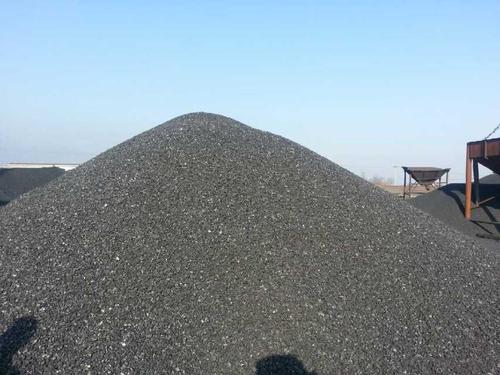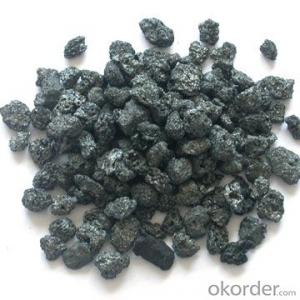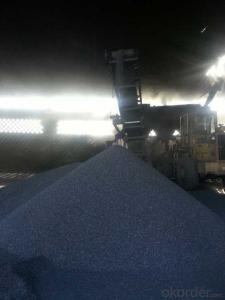Carbon Additive FC90-95 with stable quality
- Loading Port:
- Tianjin
- Payment Terms:
- TT OR LC
- Min Order Qty:
- 20 m.t.
- Supply Capability:
- 3000 m.t./month
OKorder Service Pledge
OKorder Financial Service
You Might Also Like
Packaging & Delivery
25kgs/50kgs/1ton per bag or as buyer's request
Specifications
Calcined Anthracite
Fixed carbon: 90%-95%
S: 0.5% max
Size: 0-3. 3-5.3-15 or as request
It used the high quality anthracite as raw materials through high temperature calcined at over 2000 by the DC electric calciner with results in eliminating the moisture and volatile matter from anthracite efficiently, improving the density and the electric conductivity and strengthening the mechanical strength and anti-oxidation. It has good characteristics with low ash, low resistvity, low sulphur, high carbon and high density. It is the best material for high quality carbon products.
Advantage and competitive of caclined anthracite:
1. strong supply capability
2. fast transportation
3. lower and reasonable price for your reference
4.low sulphur, low ash
5.fixed carbon:95% -90%
6..sulphur:lower than 0.3%
General Specification of Calcined Anthracite:
| FC | 95 | 94 | 93 | 92 | 90 |
| ASH | 4 | 5 | 6 | 6.5 | 8.5 |
| V.M. | 1 | 1 | 1 | 1.5 | 1.5 |
| S | 0.3 | 0.3 | 0.3 | 0.35 | 0.35 |
| MOISTURE | 0.5 | 0.5 | 0.5 | 0.5 | 0.5 |
Pictures

We are also strong at below materials, please contact us if you are interested in any of them:
Calcined Petroleum Coke
Carbon Electrode Paste
Carbon Electrode
- Q: What is the role of carbonation in carbonated drinks?
- The purpose of carbonation in carbonated drinks is to give them their characteristic refreshing and bubbly sensation. Carbonation occurs when carbon dioxide gas is dissolved into a liquid, usually water, under pressure. This process produces carbonic acid, which adds a tangy taste to the drink. Carbonation serves multiple functions in carbonated beverages. Firstly, it enhances the flavor by creating a unique bubbly sensation that delights the taste buds and provides a refreshing feeling in the mouth. The effervescence resulting from carbonation also adds to the overall sensory experience, making the drink more enjoyable to consume. Additionally, carbonation acts as a natural preservative in carbonated drinks. The presence of carbon dioxide gas inhibits the growth of bacteria and other microorganisms, thus extending the shelf life of the beverage. This is especially important for soft drinks that are often stored for long periods before being consumed. Furthermore, carbonation plays a role in the presentation of carbonated drinks. The release of carbon dioxide gas creates bubbles and fizz, making the beverage visually appealing and enticing. This visual appeal is often associated with a sense of luxury and indulgence. In summary, carbonation is a vital element of carbonated drinks as it contributes to their taste, preservation, and visual appeal. It enhances the sensory experience and adds to the overall enjoyment of these beverages.
- Q: How does carbon impact the prevalence of tsunamis?
- The prevalence of tsunamis is not directly impacted by carbon dioxide. Tsunamis primarily occur due to undersea earthquakes, volcanic eruptions, or underwater landslides. These events release massive amounts of energy into the water, creating powerful waves that can travel across the ocean and cause devastating destruction upon reaching the coast. Although tsunamis are not directly caused by carbon dioxide emissions, there is a connection to climate change, which can indirectly influence the frequency and impact of these natural disasters. The increased levels of carbon dioxide and other greenhouse gases in the atmosphere contribute to global warming, resulting in the rise of sea levels. As the sea levels rise, coastal areas become more susceptible to the destructive force of tsunamis, as the waves can penetrate further inland. Additionally, climate change can also have an impact on the frequency and intensity of extreme weather events like hurricanes and tropical storms. These weather patterns can trigger underwater landslides or increase the likelihood of volcanic eruptions, both of which can lead to the occurrence of tsunamis. In conclusion, while carbon dioxide emissions do not directly cause tsunamis, they do play a role within the broader context of climate change. This indirect impact can result in rising sea levels and the potential for more frequent extreme weather events, ultimately affecting the prevalence and impact of tsunamis.
- Q: Does alumina react with carbon?
- NotThe smelting of Al in industry can only be done by electrolysis. Even at high temperatures, the reducibility of C is not as strong as Al, and the melting point of Al2O3 is very high. At this temperature, C has been gasified
- Q: How is carbon used in the production of ink?
- Carbon is used in the production of ink as a pigment, providing the black color commonly seen in inks.
- Q: How does carbon impact the acidity of rainfall?
- Carbon does impact the acidity of rainfall through a process known as acid rain. When carbon dioxide (CO2) is released into the atmosphere, it combines with water (H2O) and forms carbonic acid (H2CO3). This reaction occurs naturally, but human activities such as burning fossil fuels and industrial processes have significantly increased the amount of carbon dioxide in the atmosphere. When carbonic acid is formed, it can react with other compounds in the air, such as sulfur dioxide (SO2) and nitrogen oxides (NOx), to form even stronger acids like sulfuric acid (H2SO4) and nitric acid (HNO3). These acids then dissolve in rainwater, forming acid rain. The presence of carbon in the atmosphere contributes to the overall acidity of rainfall. Acid rain has detrimental effects on the environment, ecosystems, and human health. It can damage forests, lakes, and rivers, leading to the depletion of fish populations and the destruction of habitats. Acid rain can also erode buildings and monuments, corrode metals, and harm crops. The impacts of carbon on the acidity of rainfall highlight the importance of reducing carbon emissions and addressing climate change. By transitioning to cleaner energy sources, implementing sustainable practices, and reducing our carbon footprint, we can help mitigate the acidity of rainfall and minimize the negative consequences associated with acid rain.
- Q: How does carbon affect the formation of permafrost thawing?
- Carbon can have a significant impact on the formation of permafrost thawing. Permafrost is a layer of frozen soil, rock, and organic matter that remains at or below freezing for at least two consecutive years. It acts as a natural carbon sink, storing large amounts of organic carbon from dead plants and animals that have accumulated over thousands of years. When permafrost thaws, this stored carbon starts to decompose, releasing greenhouse gases such as carbon dioxide and methane into the atmosphere. The carbon released from permafrost thawing contributes to the overall increase in greenhouse gas concentrations, exacerbating climate change. Additionally, as permafrost thaws, it becomes more vulnerable to erosion and subsidence, leading to changes in the landscape and the release of even more carbon. This process can create a positive feedback loop, where the released carbon further accelerates permafrost thawing, resulting in more carbon emissions. Furthermore, permafrost thawing can also impact the stability of infrastructure built on frozen ground, such as roads, buildings, and pipelines, leading to significant economic and environmental consequences. In summary, carbon plays a crucial role in the formation and thawing of permafrost. The release of carbon from thawing permafrost contributes to climate change, accelerates the thawing process, and has various environmental and economic impacts. Addressing carbon emissions and finding ways to mitigate permafrost thawing is essential to combatting climate change and preserving the stability of these frozen ecosystems.
- Q: How does carbon impact the availability of freshwater resources?
- The availability of freshwater resources is impacted by carbon in several interconnected ways. Climate change is one of the primary means through which carbon affects freshwater availability. The burning of fossil fuels and other human activities result in increased levels of carbon dioxide in the atmosphere, which contributes to global warming. This warming, in turn, leads to changes in precipitation patterns, including alterations in rainfall distribution and intensity. The emission of carbon also leads to warmer temperatures, which can cause higher rates of evaporation and more frequent and severe droughts in specific regions. These droughts reduce the amount of water accessible for freshwater resources like rivers, lakes, and reservoirs. Furthermore, the shifting climate can disrupt natural water cycles, impacting the replenishment of groundwater aquifers, which are essential sources of freshwater. Moreover, the quality of freshwater resources is impacted by carbon. The increased carbon emissions reacting with atmospheric moisture result in acid rain, which acidifies freshwater bodies and renders them unsuitable for many aquatic organisms. This disruption to ecosystems can lead to the loss of species that depend on freshwater resources for their survival. Another manner in which carbon affects freshwater availability is through its influence on land use. The conversion of forests and wetlands into agricultural or urban areas releases carbon stored in vegetation and soil. This not only adds to carbon emissions but also diminishes the ability of natural ecosystems to retain and filter water. Forests, for instance, play a crucial role in maintaining the water cycle by absorbing rainfall and gradually releasing it into streams and groundwater. Deforestation disrupts this process and can result in reduced water availability downstream. In conclusion, carbon emissions have a profound impact on the availability of freshwater resources. Through climate change, carbon alters precipitation patterns, resulting in droughts and decreased water availability. It also affects the quality of freshwater through phenomena like acid rain. Moreover, land-use changes driven by carbon emissions can further diminish freshwater availability by disrupting natural water cycles.
- Q: How does carbon affect the preservation of historical artifacts?
- Carbon can have both positive and negative effects on the preservation of historical artifacts. On one hand, carbon-based materials such as paper, wood, and textiles are susceptible to degradation over time. These artifacts can be easily affected by environmental factors such as temperature, humidity, and exposure to pollutants, leading to their decay. Carbon-based materials can also be attractive to pests like insects and rodents, further accelerating their deterioration. On the other hand, carbon-based materials like charcoal and carbonates can play a crucial role in the preservation of artifacts. Charcoal, for example, can be used to date artifacts through carbon dating, providing valuable insights into their age and historical significance. Carbonates, such as calcium carbonate found in limestone, can act as protective coatings, forming a barrier against environmental factors and preventing further decay. Moreover, carbon-based conservation treatments, such as consolidation with adhesives or impregnation with polymers, can help stabilize and strengthen fragile artifacts. These treatments can increase the artifact's resistance to environmental factors and provide structural support, extending its lifespan for future generations. It is important to note that while carbon-based materials can impact the preservation of historical artifacts, other factors like light exposure, handling, and storage conditions also play significant roles. Therefore, a comprehensive preservation strategy should consider all these factors to ensure the longevity and conservation of these valuable historical artifacts.
- Q: What is carbon dating?
- Carbon dating is a scientific method used to determine the age of ancient artifacts or fossils by measuring the amount of carbon-14 remaining in them.
Send your message to us
Carbon Additive FC90-95 with stable quality
- Loading Port:
- Tianjin
- Payment Terms:
- TT OR LC
- Min Order Qty:
- 20 m.t.
- Supply Capability:
- 3000 m.t./month
OKorder Service Pledge
OKorder Financial Service
Similar products
Hot products
Hot Searches
Related keywords
























